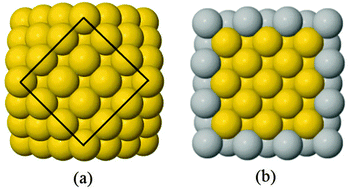
Authors (4): A. L. Gould, C. J. Heard, A. J. Logsdail, C. R. A. Catlow
Themes: Design DOI: 10.1039/c4cp00753k
Citations: 40
Pub type: article-journal
Pub year: 2014
Publisher: Royal Society of Chemistry (RSC)
Issue: 39
License:
Publication date(s): 2014/04/15 (online)
Pages: 21049-21061
Volume: 16 Issue: 39
Journal: Physical Chemistry Chemical Physics
Link: http://pubs.rsc.org/en/content/articlepdf/2014/CP/C4CP00753K
URL: http://dx.doi.org/10.1039/c4cp00753k
AuAg nanoclusters are promising supported co-catalysts for photocatalytic hydrogen reduction. However, beyond the quantum regime (N > 100) little is known about how the electronic properties of these nanoparticles are affected by chemical ordering. We investigate the effects of chemical ordering on the properties of 147-atom cuboctahedral AuAg nanoclusters, using empirical potentials coupled with an atomic-swap basin-hopping search to optimise the elemental distribution, with the lowest energy arrangements then reminimised using Density Functional Theory (DFT). Force-field calculations show Au atoms preferentially occupy sub-surface positions in the bimetallic structures, which results in the formation of a pseudo-onion structure for Ag-rich compositions. At the DFT-level, however, an Ag core surrounded by an Au shell (Ag@Au) is energetically favoured, as electron density can be drawn more readily when Au atoms are positioned on the nanocluster surface, thus resulting in a partial negative charge. Core@shell configurations are analogous to structures that can be chemically synthesised, and further detailed electronic analysis is discussed in the context of nanocluster applications to co-catalysed photocatalysis.
| Name | Description | Publised |
|---|---|---|
| c4cp00753k1.pdf | Supl. data for Segregation effects on the properties of (AuAg)147... | 2014 |
<< Previous Back Next >>